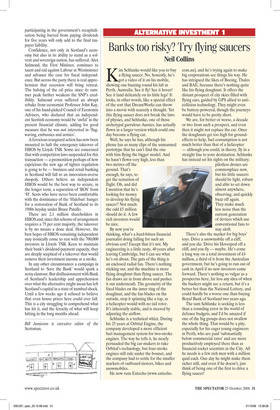Banks too risky? Try flying saucers
Neil Collins
Kigm Schlunke would like you to buy a flying saucer. No, honestly, he’s ot a video of it on his mobile, showing one buzzing round his lab in Perth, Australia. See it fly! See it hover! See it land delicately on its little legs! It looks, in other words, like a special effect of the sort that DreamWorks can throw into a movie with scarcely a thought. Yet this flying saucer does not break the laws of physics, and Schlunke, one of those archetypal garrulous Aussies, has actually flown in a larger version which could one day become a flying car.
Well, he says he has, although his phone has so many clips of the unmanned prototype that he can’t find the one with him flying the bigger model. And he hasn’t flown very high, less than two metres off the ground. That’s enough, he says, to get the sensation of flight. Oh, and did I mention that he’s looking for money to develop his flying saucer? Not much: the odd £5 million should do it. A few rich investors would be nice.
By now you’re thinking, what’s a hard-bitten financial journalist doing falling for such an obvious con? Except that it’s not. My engineering is a little rusty, 40 years after leaving Cambridge, but I can see what he’s on about. The guts of the thing is an enclosed radial fan. There’s nothing sticking out, and the machine is more flying doughnut than flying saucer. The fan draws air in from above and pushes it out underneath. The geometry of the fixed blades on the inner ring of the doughnut, and the fan blades on the outside, stop it spinning like a top, as a helicopter would with no tail rotor. It’s inherently stable, and is steered by adjusting the airflow.
Schlunke is a technical whizz. During his 25 years at Orbital Engine, the company developed a more efficient fuel management system for two-stroke engines. The way he tells it, he nearly persuaded the big car-makers to take Orbital’s technology, but four-stroke engines still rule under the bonnet, and the company had to settle for the smaller markets of outboard motors, bikes and snowmobiles.
He now runs Entecho (www.entecho. com.au), and he’s trying again to make big corporations see things his way. He has intrigued the likes of Boeing, Thales and BAE, because there’s nothing quite like his flying doughnut. It offers the distant prospect of city skies filled with flying cars, guided by GPS allied to anticollision technology. They might even be battery-powered, though the journeys would have to be pretty short.
We are, for better or worse, a decade or two from such a prospect, and even then it might not replace the car. Once the doughnuts get too high for groundeffects to help, fuel consumption is not much better than that of a helicopter — although you could, in theory, fly in a straight line to your destination. Schlunke has instead set his sights on the military; pilotless drones are commonplace now, but his little saucers should be light, robust and able to set down almost anywhere, observing, and quickly buzz off again.
They make much less noise than the current generation of devices which use conventional fans to stay aloft.
There’s also the market for big boys’ toys. Drive a snowmobile off a cliff, and you die. Drive his Hoverpod off a cliff, and you fly — maybe. He’s come a long way on a total investment of £4 million, a third of it from the Australian government, but he’s going to run out of cash in April if no new investors come forward. There’s nothing so vulgar as a prospectus here, far less any idea of when the backers might see a return, but it’s a better bet than the National Lottery, and could hardly be a worse one than buying Royal Bank of Scotland two years ago.
The sum Schlunke is seeking is less than a rounding error in the world of defence budgets, and I’d be amazed if one of the big groups does not swallow the whole thing. That would be a pity, especially for his eager young engineers in Perth, who are paid ‘substantially below commercial rates’ and are more productively employed there than as financial rocket scientists in the City. All he needs is a few rich men with a million quid each. One day he might make them richer still, and even if he doesn’t, just think of being one of the first to drive a flying saucer!


















































































 Previous page
Previous page